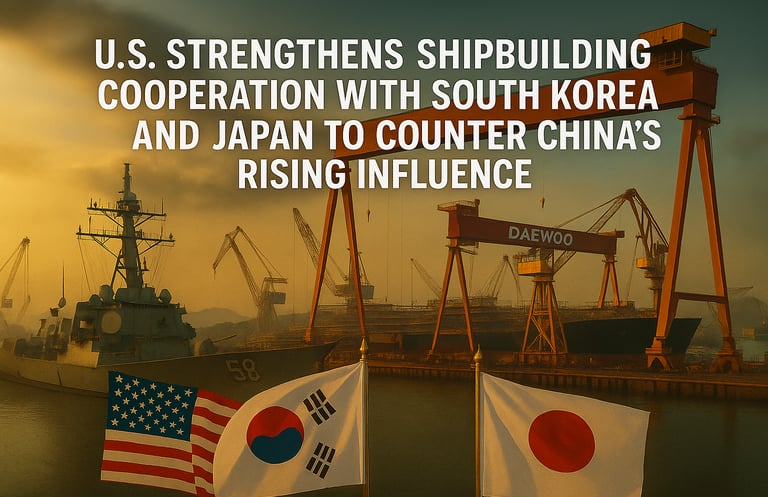U.S. Strengthens Shipbuilding Cooperation with South Korea and Japan to Counter China
The U.S. partners with South Korea and Japan to revitalize shipbuilding, counter China’s naval dominance, boost jobs, and reinforce security in the Pacific
Raja Awais Ali
8/17/20252 min read


U.S. Strengthens Shipbuilding Cooperation with South Korea and Japan to Counter China’s Rising Influence
In a significant strategic move, the United States has begun deepening cooperation with South Korea and Japan to enhance shipbuilding capabilities and counter China’s growing maritime dominance. On August 17, 2025, a delegation of U.S. lawmakers visited major shipyards in Seoul and Tokyo, where discussions focused on expertise, technology sharing, and potential joint ventures aimed at revitalizing America’s industrial strength at sea. This development comes amid Washington’s mounting concerns over Beijing’s rapid military expansion and growing influence in the Asia-Pacific region.
For decades, the U.S. was considered a global leader in shipbuilding. However, the industry declined as production shifted overseas, costs escalated, and foreign competitors captured the market. In contrast, South Korea and Japan established themselves as global leaders, producing advanced warships, commercial vessels, and energy carriers that dominate shipping lanes worldwide. Today, South Korea’s Hyundai Heavy Industries and Japan’s Mitsubishi Heavy Industries are recognized as innovators in naval engineering. U.S. officials view partnerships with these nations as essential to filling the gap and strengthening America’s readiness for any future maritime conflict.
The cooperation carries critical geopolitical importance. China has rapidly expanded its naval fleet, now boasting the world’s largest navy with modern destroyers, aircraft carriers, and submarines capable of projecting power across the South China Sea, East China Sea, and beyond. Experts warn that if the U.S. fails to modernize quickly, it risks losing its longstanding naval edge, potentially shifting the balance of power in the Pacific. By working closely with Asian allies, Washington aims not only to deter Beijing but also to reassure partners such as the Philippines, Taiwan, and Vietnam of its commitment to regional security.
Economically, the initiative holds immense promise. Revitalizing the shipbuilding industry could generate thousands of high-paying jobs in the U.S., boost investments in steel, energy, and technology sectors, and reduce dependence on Chinese supply chains. Beyond warships, the collaboration could expand into green cargo ships, LNG carriers, and renewable energy vessels, aligning with global environmental goals. American lawmakers emphasized that this is not an arms race but a path to creating regional stability and economic balance.
Beijing’s reaction has been sharp. Chinese state media accused Washington of pursuing a “Cold War-style containment” and warned that shipbuilding cooperation with Seoul and Tokyo could destabilize the region. However, both South Korea and Japan have signaled support for this strategic alignment, seeing it as an opportunity to strengthen their defense industries while deepening trilateral security ties with the United States.
For ordinary Americans, this story is not just about distant geopolitics—it reflects Washington’s urgent push to secure supply chains, protect global trade, and reinforce national security. Most importantly, it marks the beginning of a new industrial era, where the U.S., together with trusted Asian allies, seeks to restore its maritime power.